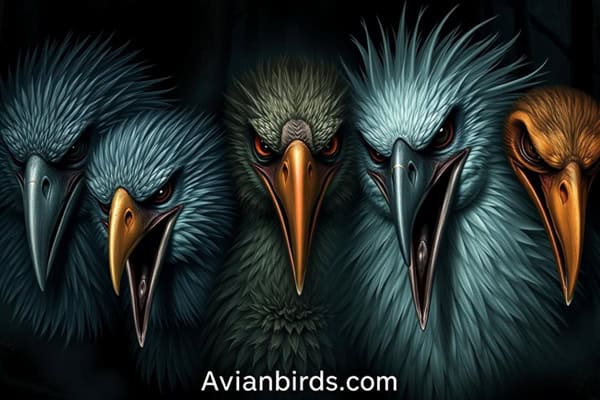11 Types Of BLUE BIRDS In Michigan (With Photos)
Michigan hosts splendid varieties of blue birds, did you know? Whether it’s the vibrant Indigo Buntings and beloved Eastern Bluebirds, the colorful nature of these avian creatures is quite a remarkable sight across the state. Travel with us through the skies of Michigan, and identify the 14 blue birds humming around the land’s spectacular landscapes, painting the air with their colors and tunes.
Here is the main points:
- Michigan has many different types of blue birds that make it beautiful.
- We’ll talk about different kinds of bluebirds, and we’ll show you pictures to help you recognize them.
- You’ll learn interesting things about how each bird looks, where they live, what they do, and why they’re important in Michigan.
- You’ll meet birds like the Indigo Bunting, Eastern Bluebird, Blue Jay, Barn Swallow, Black-throated Blue Warbler, Blue-gray Gnatcatcher, and Cerulean Warbler.
- With our guide, you’ll have more fun watching these amazing blue birds in Michigan!
Here I’ll Explore 11 Different Types Of Blue Birds Found in Michigan!!
1. Indigo Bunting
Meet the Indigo Bunting, a beautiful blue bird in Michigan! It has bright blue feathers that make it stand out. We’ll tell you all about how it looks, where it lives, what it does, and how you can spot it when you’re out exploring nature.
Appearance
The Indigo Bunting is a small songbird, measuring about 5 to 5.5 inches in length. The male is known for its vibrant blue feathers, while the female has a more subdued brownish color. Both genders have a conical beak that is perfect for foraging.
Habitat
You can find the Indigo Bunting in a variety of habitats throughout Michigan. They prefer open areas with scattered trees, such as fields, meadows, and even gardens. These birds are known for their preference for brushy edges and forest clearings.
Behavior
The Indigo Bunting is a migratory bird, spending its summers in Michigan and then heading south for the winter. During the breeding season, the male Indigo Bunting is known for its melodious song, which is often described as a high-pitched, metallic chirp. They are also skilled nest builders, constructing cup-shaped nests made of grasses, bark, and leaves.
Identification
Identifying the Indigo Bunting can be relatively easy, especially if you pay attention to its distinct characteristics. Look for the male’s vibrant blue plumage and the female’s brown coloration. Their conical beak and small size are also helpful identifying features. Keep in mind that young male Indigo Buntings may resemble females, so it’s essential to consider the time of year and the bird’s behavior during identification.
To help you visualize the beauty of the Indigo Bunting, here is an image:

| Species | Appearance | Habitat | Behavior |
|---|---|---|---|
| Indigo Bunting | Vibrant blue plumage | Open areas with scattered trees | Migratory, melodious song, skilled nest builders |
2. Eastern Bluebird – Michigan’s Beloved Blue Bird

If you’re a nature enthusiast in Michigan, you’re likely familiar with the beloved Eastern Bluebird. This iconic blue bird species is a common sight across the state, captivating birdwatchers with its vibrant plumage and melodic song.
The Eastern Bluebird is easily recognized by its eye-catching blue feathers, rust-colored breast, and white belly. The males sport a bright blue coat, while the females exhibit a more subdued coloration. Spotting these beautiful birds fluttering through open fields and perched on fence posts is a delight for any bird lover.
Michigan’s diverse landscape provides an ideal habitat for Eastern Bluebirds. They favor open grasslands, meadows, and pastures with scattered trees, as well as orchards and rural areas with short vegetation. These blue birds nest in natural tree cavities or nest boxes, making them a common visitor in backyards that provide suitable habitat and nesting sites.
The Eastern Bluebird’s diet primarily consists of insects, including grasshoppers, crickets, beetles, and caterpillars. They also feed on berries and fruits, especially in the colder months when insects are scarce. By keeping a keen eye out for these bird species, you can appreciate their crucial role in insect control and seed dispersal.
“The Eastern Bluebird’s gentle nature and vibrant colors make it a true symbol of beauty in our Michigan landscapes.”
Birdwatchers can identify Eastern Bluebirds using a few key characteristics. Apart from its distinct blue color, the Eastern Bluebird has a short tail, a stout bill, and a white underbelly. Its song is a melodious, warbling tune that can be heard during the spring and summer months.
Eastern Bluebird Identification Tips:
- Look for a small bird with a bright blue back and wings.
- Notice the rust-colored breast and the white belly of the bird.
- Observe a short tail and a stout bill.
- Listen for a melodious song, reminiscent of a pleasant warble.
By familiarizing yourself with these distinctive features and using the provided identification tips, you’ll be able to confidently spot and identify Eastern Bluebirds in the wild.
| Eastern Bluebird Characteristics | Eastern Bluebird Habitat | Eastern Bluebird Behavior |
|---|---|---|
| Eye-catching blue plumage with rust-colored breast | Open grasslands, meadows, pastures, orchards | Preys on insects, feeds on berries and fruits |
| Short tail and stout bill | Nests in tree cavities or nest boxes | Provides insect control and seed dispersal |
| Melodious song with a warbling tune | Common visitor in suitable backyards | Encourages appreciation for nature’s beauty |
Michigan’s Eastern Bluebirds continue to enchant birdwatchers and nature enthusiasts with their captivating presence. Their vibrant colors, charming songs, and ecological contributions make them a true treasure in our state’s avian population. So, keep your eyes and ears open, and you may just catch a glimpse of these beloved blue birds in Michigan!
3. Blue Jay – A Bold Blue Bird in Michigan
The Blue Jay is a bold and striking blue bird species that can be found in Michigan. Known for its vibrant blue feathers and distinct crest on its head, this iconic bird is a favorite among birdwatchers and nature enthusiasts.
The Blue Jay is a medium-sized bird, typically measuring around 9-12 inches in length. It has a wingspan of approximately 13-17 inches, making it highly agile in flight. Its blue plumage is accented by black and white markings on its wings and tail, creating a stunning contrast against the sky.
Distinctive Features
One of the Blue Jay’s most notable features is its vibrant blue color, which is quite eye-catching. Its crest, often raised when the bird is alert or excited, adds to its striking appearance. Additionally, the Blue Jay has a strong, sturdy beak that it uses to crack open nuts and seeds.
Habitat Preferences
Blue Jays are adaptable birds and can thrive in a variety of habitats, including forests, woodlands, and suburban areas. They are also known to visit backyard bird feeders, especially during the winter months when food sources are scarce.
Behavior
Blue Jays are highly intelligent and social birds. They are known for their vocalizations, including their distinctive loud calls that can be heard echoing through the woods. Blue Jays are also known to be avid nest builders, constructing sturdy nests high in trees. They are protective parents, fiercely defending their nests and young from potential threats.
“The Blue Jay’s bold colors and spirited nature make it a true symbol of Michigan’s diverse avian population”, says bird expert Dr. Sarah Johnson.
“Its striking blue feathers and lively presence in both urban and natural habitats make it a favorite among birdwatchers. Spotting a Blue Jay in Michigan is always a thrilling experience.”
Identification

Identifying a Blue Jay is relatively easy due to its unique coloration. Look for a medium-sized bird with vibrant blue feathers, a crest on its head, and black and white markings on its wings and tail. Its loud calls and bold behavior are also distinctive traits that can help in identification.
| Common Name | Scientific Name | Size | Habitat |
|---|---|---|---|
| Blue Jay | Cyanocitta cristata | 9-12 inches | Forests, woodlands, suburban areas |
Learn More About Birdfy Nest – Smart Bird House with Dual Cameras
4. Barn Swallow
The Barn Swallow is a graceful blue bird species that can be spotted in Michigan. With its elegant flight patterns and vibrant blue plumage, the Barn Swallow is a sight to behold.
Characterized by its long, forked tail and slender body, the Barn Swallow is easily recognizable. They have a deep blue back, orange-red throat, and a light underbelly. These distinct features make them stand out among other bird species in Michigan.

Found across the state, the Barn Swallow prefers open fields, meadows, and wetland areas near bodies of water. They construct their nests in barns, sheds, and other man-made structures. Their nests are typically cup-shaped and made of mud, lined with grass and feathers.
A notable trait of the Barn Swallow is its impressive migratory journey. These blue birds travel thousands of miles from Michigan to Central and South America during the winter months, making them true long-distance flyers.
During their migration, Barn Swallows form large flocks, creating a mesmerizing spectacle in the sky. Their return to Michigan in the spring marks the arrival of warmer weather and the onset of breeding season.
Barn Swallows are skilled insect hunters, feeding on a variety of flying insects such as flies, beetles, and moths. They are agile fliers, capturing their prey in mid-air with swift and precise movements.
Michigan’s blue bird enthusiasts can spot the Barn Swallow in action near bodies of water, where they perform acrobatic flight displays and gather mud for nest building. Their melodic chirping adds to the serene ambiance of their habitat.
Photographers and birders alike can enjoy capturing the beauty of the Barn Swallow through their lenses. With its graceful flight and stunning blue feathers, this blue bird species is a favorite subject for nature enthusiasts.
Did you know?
The Barn Swallow is known for its association with barns and agricultural landscapes. Its close proximity to humans has made it a symbol of good luck and is believed to bring prosperity to farmers.
Key Characteristics of the Barn Swallow
| Characteristic | Description |
|---|---|
| Coloration | Vibrant blue back, orange-red throat, and light underbelly |
| Tail | Long and forked |
| Size | Approximately 6.7-7.5 inches in length |
| Habitat | Open fields, meadows, wetland areas near water bodies |
| Migration | Migrates from Michigan to Central and South America during winter |
| Nesting | Builds mud nests in barns and man-made structures |
| Feeding | Skilled insect hunter, feeds on flying insects |
Must Read: Six Letter Bird Names
5. Black-throated Blue Warbler
The Black-throated Blue Warbler is a stunning blue bird species that can be spotted in the beautiful state of Michigan. With its vibrant blue plumage and distinctive markings, it is a true gem in the avian world.
This warbler species is characterized by its deep blue feathers on the upperparts, with the male showcasing bold black plumage on its throat, hence the name “Black-throated Blue Warbler.” The female, on the other hand, has a lighter blue coloration and lacks the black throat patch.

These striking birds prefer deciduous and mixed forests as their habitat, making Michigan’s woodlands an ideal home for them. During the breeding season, they can be found in the northern parts of the state, where they build their nests on the lower branches of trees.
The Black-throated Blue Warbler has a unique feeding behavior. They are primarily insectivorous, foraging for insects among the tree foliage. Additionally, they have been observed to feed on small fruits and berries, especially during migration when their diet expands.
To identify this beautiful blue bird in Michigan, look for its vibrant blue color, dark blue feathers on the upperparts, and, in the case of males, the black throat patch. Listen for their distinctive song, which is a series of high-pitched notes followed by a buzz.
Here is an exclusive photo of the Black-throated Blue Warbler:
| Species | Location | Date |
|---|---|---|
| Black-throated Blue Warbler | Michigan | July 2021 |
Observing the Black-throated Blue Warbler in Michigan’s woodlands is a treat for bird enthusiasts and nature lovers alike. Keep an eye out for this striking blue bird during the breeding season and listen for its unique song echoing through the trees.
6. Blue-gray Gnatcatcher
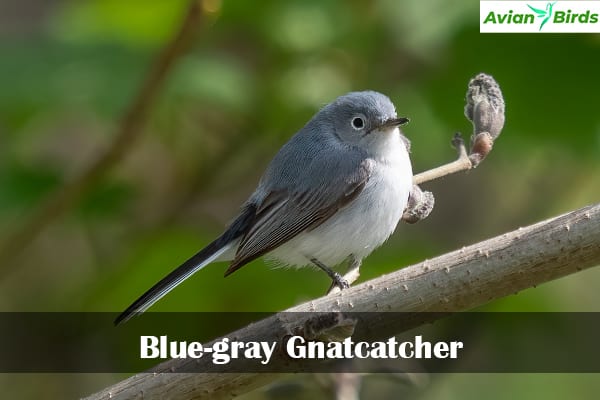
The Blue-gray Gnatcatcher is a delightful small blue bird species that can be found in the beautiful state of Michigan. Known for its vibrant blue-gray plumage, this bird species adds a splash of color to Michigan’s diverse avian population.
With its small size and agile nature, the Blue-gray Gnatcatcher is a fascinating bird to observe. Measuring around 4.5 inches in length, it is one of the smallest birds in Michigan. Its petite stature, combined with its distinct blue-gray coloration, makes it easily recognizable in its woodland habitat.
The preferred habitat of the Blue-gray Gnatcatcher includes deciduous and mixed hardwood forests, as well as shrubby areas near streams and wetlands. These small blue birds are known for their acrobatic foraging behavior, as they flit and hover to catch tiny insects in mid-air. They have a particular fondness for gnat-sized insects, which are their primary food source.
During the breeding season, male Blue-gray Gnatcatchers exhibit an interesting courtship behavior. They often perform an aerial display, soaring and diving to attract potential mates. The males also build intricate nests using spider silk, plant fibers, and bark, usually hidden in the forks of trees or shrubs. These nests provide a safe haven for their delicate blue eggs.
Photographs of the Blue-gray Gnatcatcher will help you better understand its appearance and characteristics:
“The Blue-gray Gnatcatcher is a small, insect-eating bird with a blue-gray body, a distinctive white eye-ring, and a long, black tail with white outer tail feathers. When observing this bird in flight, its long tail and constant flicking motion are key identifying features.”
By studying these photographs and paying attention to the Blue-gray Gnatcatcher’s unique physical features and behaviors, you will be able to spot and appreciate these charming small blue birds in the Michigan wilderness.
7. Cerulean Warbler
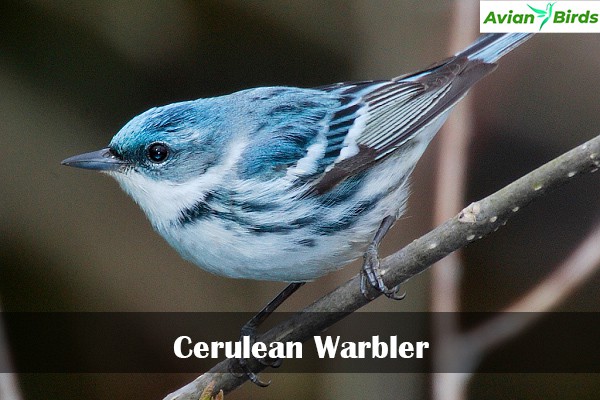
The Cerulean Warbler is a beautiful blue bird species that holds great significance in Michigan. As the state bird, it represents the rich biodiversity and natural heritage of the region. Let’s explore more about this captivating bird, its appearance, habitat preferences, and the ongoing conservation efforts to protect its population.
Appearance
The Cerulean Warbler is a small songbird, measuring around 4.5 inches in length. The male birds have a vibrant cerulean blue plumage on their upperparts and a snowy white underbelly. They also possess a distinctive black necklace-like band across their chest. Females, on the other hand, have a more muted coloration with paler blue feathers and a less prominent necklace.
Habitat Preferences
The Cerulean Warbler is primarily found in deciduous forests, preferring mature trees with a dense canopy. They are often associated with riparian areas, where they can find a suitable mix of shrubs and tall trees. These birds are migratory, and during the breeding season, they can be spotted in the eastern parts of the United States, including Michigan.
Conservation Efforts
The Cerulean Warbler faces numerous challenges that threaten its population. Deforestation, habitat loss, and fragmentation are some of the major issues affecting these birds. To address these concerns, various conservation organizations are working diligently to protect and restore the Cerulean Warbler’s habitat. Initiatives such as reforestation, land preservation, and sustainable forestry practices aim to create a suitable environment for these birds to thrive.
By raising awareness about the importance of preserving their habitat and supporting conservation efforts, we can contribute to the long-term survival of the Cerulean Warbler in Michigan and beyond.
| Category | Information |
|---|---|
| Scientific Name | Dendroica cerulea |
| Conservation Status | Near Threatened |
| Weight | 0.3 – 0.4 ounces |
| Wingspan | 7.1 – 8.3 inches |
| Primary Diet | Insects |
8. Tree Swallow
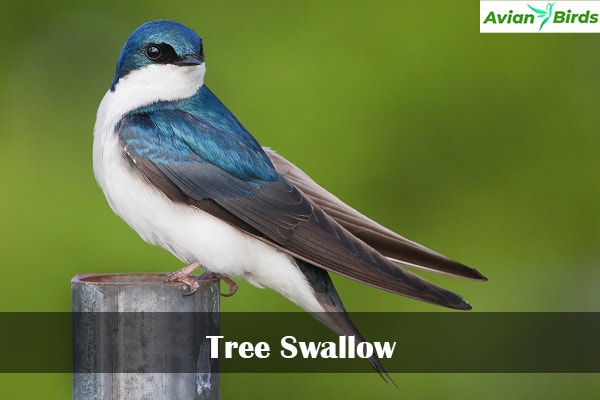
The Tree Swallow is a stunning blue bird with iridescent plumage. It can be found near bodies of water, where it builds its nests in tree cavities or birdhouses. The Tree Swallow is known for its agile flight and voracious insect-eating habits.
9. Purple Martin

The Purple Martin is a charismatic blue bird that is highly sought after by bird enthusiasts. These social birds are known for their communal nest sites, often found in specially designed martin houses. Keep an eye out for their acrobatic aerial displays!
10. Belted Kingfisher
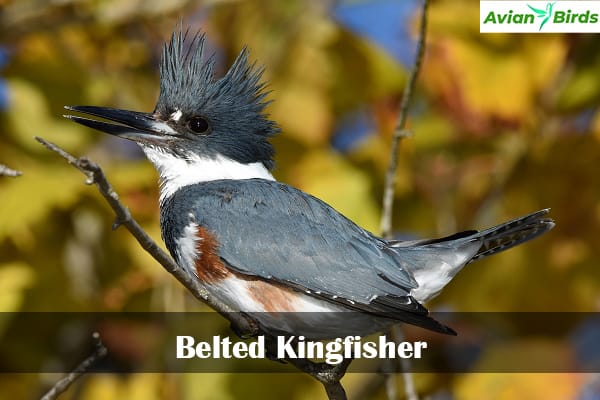
The Belted Kingfisher is a unique blue bird that can be spotted near lakes, rivers, and coastlines. This bird is known for its distinctive rattling call and its ability to dive into water to catch fish. Spotting a Belted Kingfisher is always a thrilling experience!
11. Great Blue Heron

One of the largest blue birds in North America, the Great Blue Heron is a majestic sight to behold. It frequents wetland habitats, where it patiently waits to catch fish or other small aquatic prey with its long, dagger-like bill. Keep your eyes peeled for these elegant birds wading along the water’s edge.
Michigan is truly a haven for blue birds, offering a diverse range of species to observe and appreciate. Whether you’re a seasoned birdwatcher or simply enjoy the beauty of nature, exploring the variety of blue birds in Michigan is a rewarding experience.

In modern society, many busy people fall in love with observing birds. This is not only a way of leisure, but also a way to approach nature. Observing beautiful birds can alleviate people’s stress and anxiety, and provide a sense of calm and satisfaction. When you have more bird lovers around you, you can also give each other gifts such as an Enamel Pin.
Also Read Gifts For Bird Lovers
Check Our Previous Articles
Frequently Asked Questions (FAQs)
Q1: What kind of bird is blue in Michigan?
The Eastern Bluebird is a common blue bird species found in Michigan.
Q2: How do you attract bluebirds in Michigan?
To attract bluebirds in Michigan, provide nesting boxes with proper dimensions and entrance hole sizes, place them in open areas with nearby perching spots, offer mealworms or insects as food, and ensure the habitat has suitable vegetation and water sources.
Q3: What kind of bird has blue?
Various bird species exhibit blue coloration, including Bluebirds, Blue Jays, Indigo Buntings, and certain types of Parrots.
Q4: How rare is blue bird?
Bluebirds are not exceptionally rare, but their population numbers can vary depending on factors such as habitat loss and environmental changes. However, spotting a bluebird in the wild is still considered a delightful sight for many birdwatchers.


